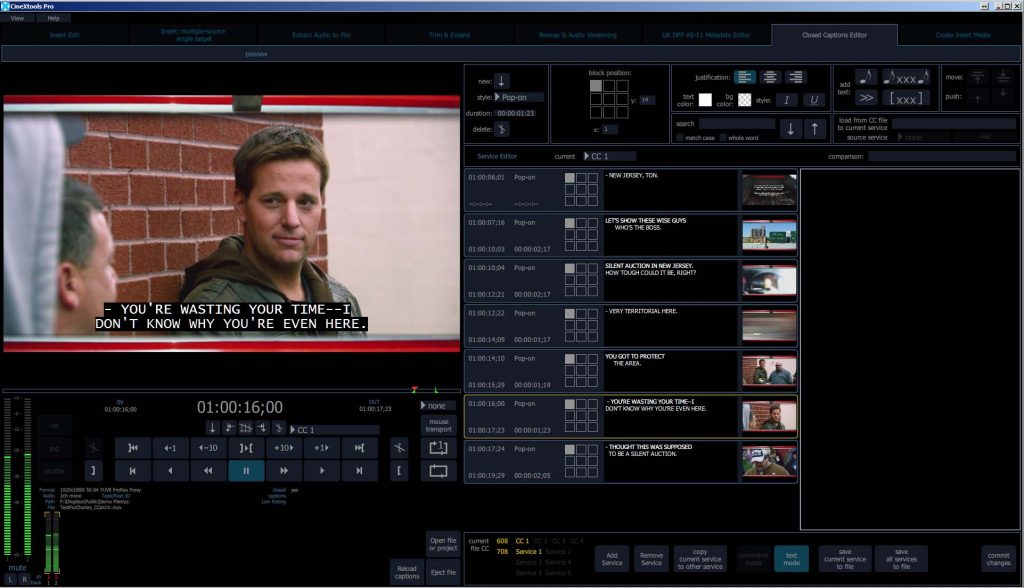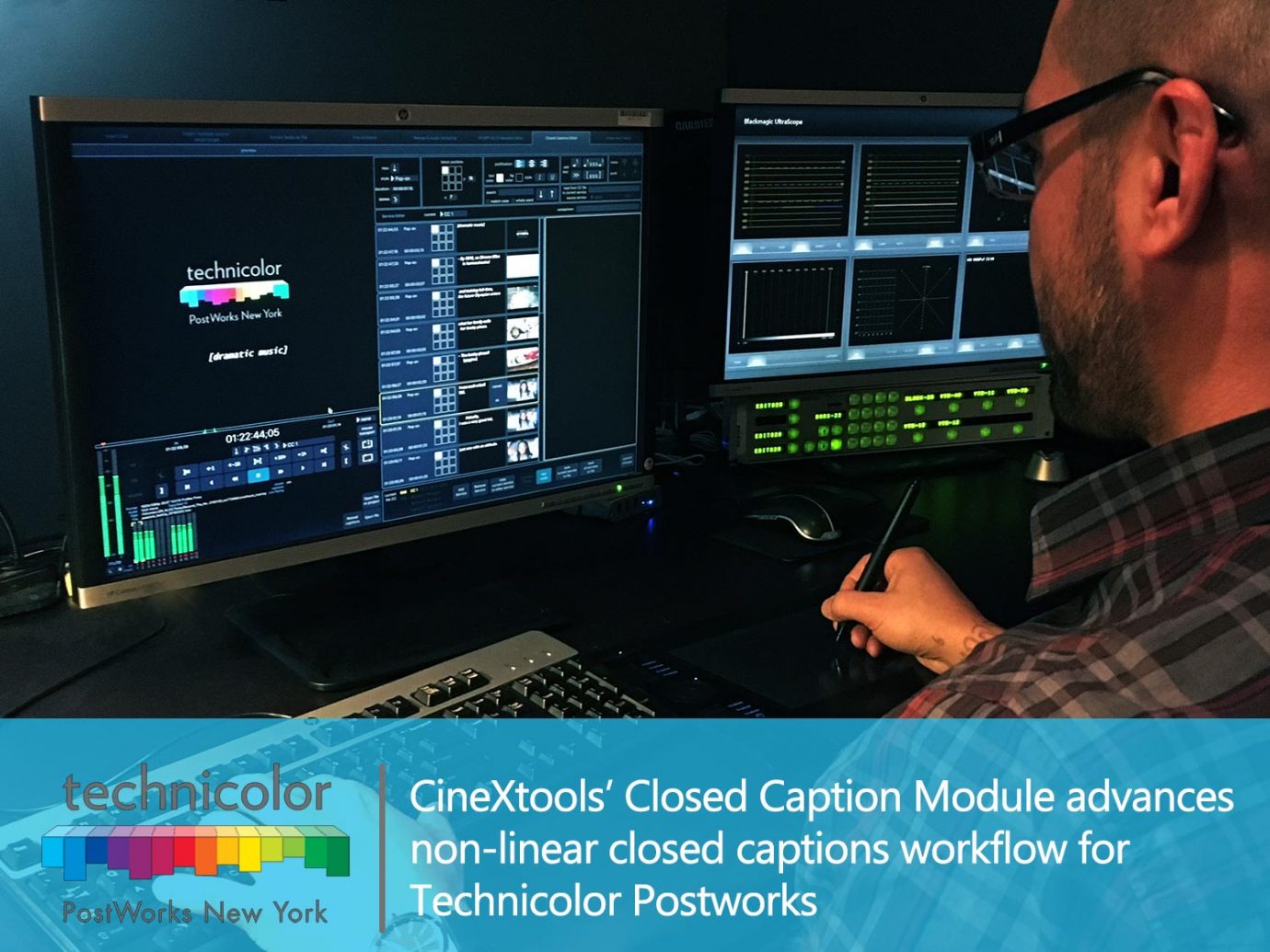PostWorks New York provides finishing services to virtually every segment of the content creation market, supporting online editorial, color grading, sound mixing, and final mastering for every conceivable file type delivered today. The ever-expanding scope of differing mastering formats for delivery to studios, networks and OTT content services can be dizzying, requiring expertise across many different platforms and workflows, many of which require closed captioning. We sat down with Matt Schneider, Director of Technology at Postworks New York, who was an early adopter of the cineXtools Closed Caption module to discuss how the new toolset has improved their captioning workflow.
 “Although closed captioning is not a new requirement, it can often be a tricky, and nuanced ‘last mile’ for final delivery workflows,” Matt says. He explains that applying closed captioning to an already-created finished master was often a slow, multi-stepped process. “Typically, the process began with a tape-to-tape ‘duplication’ style workflow, where one VTR would duplicate to another with a closed-caption encoder inline, reading from a .cap file. This process is real-time and required three dedicated pieces of hardware.” He continues, “If an error were found in the caption text – a misspelling for example – or if the narrative content of the programming changed, the entire process had to be repeated. Tape stock would be consumed, time would be lost, with little finished product to show for our time and effort.”
“Although closed captioning is not a new requirement, it can often be a tricky, and nuanced ‘last mile’ for final delivery workflows,” Matt says. He explains that applying closed captioning to an already-created finished master was often a slow, multi-stepped process. “Typically, the process began with a tape-to-tape ‘duplication’ style workflow, where one VTR would duplicate to another with a closed-caption encoder inline, reading from a .cap file. This process is real-time and required three dedicated pieces of hardware.” He continues, “If an error were found in the caption text – a misspelling for example – or if the narrative content of the programming changed, the entire process had to be repeated. Tape stock would be consumed, time would be lost, with little finished product to show for our time and effort.”
While file-based workflows and later file-based delivery made some aspects of the finished asset delivery simpler, it hadn’t improved their caption workflows. He explains, “The investment we had made in a hardware-focused process was a recent one, so we continued to rely on our ‘baseband’ SDI tape-style workflows, eventually substituting non-linear editing tools in place of where the VTRs used to go. NLEs such as Avid Media Composer brought some relief with the ability to apply captioning in the NLE and export OP1a MXF files with that captioning embedded. But making last minute changes to correct for errors, or if the client’s narrative content changed, required a complete re-export of the finished file.”
He comments, “Ironically, we had taken a step backward with file-based delivery. We lost the ability to output from NLEs to VTRs and the ability to ‘punch in’ fixes to tape. This loss of workflow efficiency extended to how changes to closed captions were managed.”

Adding another layer of complication to the file delivery process, the industry’s acceptance of ProRes as a mastering codec and Quicktime as a mastering file type meant that adding captions to already-created ProRes Quicktime masters required multiple real-time processes. Matt notes, “Adding captions to ProRes deliveries meant involving a mixture of VTRs, NLEs, and even differing teams of people with differing expertise. The process was, simply put, messy!”
Enter cineXtools from Cinedeck. As the only software platform capable of insert-editing into closed files, cineXtools was already a convention-breaking industry milestone. With the release of the Closed Caption Module last year, Cinedeck brought forward a closed caption editing toolset with the convenience of an add-on license. Matt says, “With this one app, PostWorks has been able to effectively erase any of the inefficiency ‘weeds’ that had sprouted up into what had previously been a well-manicured process.”
The cineXtools captions workflow take as little as a few minutes or even seconds to add or edit captions within finished delivery files. “We recently had a large project that needed digital captions conversion from standard def captions,” says Matt. “The new CC module gave us the ability to convert those 608 captions to proper 708 and edit text right into the finished file, all ‘live’ and without the need to re-export or re-wrap our Quicktime deliveries.”
While the caption-editing toolset is still an emerging one for cineXtools, Matt says he’s already started training various PostWorks teams on the software’s usage and its workflow. “Thus far we have delivered to A&E Networks ProRes Quicktimes created out of Avid Media Composer with both 608 and 708 captions, both of which were added to this finished file with cineXtools in under 5 minutes. We’re looking forward to using this methodology to deliver to other studios and networks,” he says.
As a final remark, Matt notes, “cineXtools reminded us that we were using nonlinear tools in a very linear way: output a finished tape or file, bring that master to another workstation and encode to yet another tape or file with captioning, and in some cases re-capture that captioned tape as another file type for ultimately delivery. cineXtools with the caption editor has brought non-linear workflows back to the forefront, making last minute changes, fixes, and edits to captioning a wildly simple and freakishly fast workflow.”
About Technicolor – Postworks:
Technicolor – PostWorks New York is the largest post production facility in New York, providing comprehensive services for film, television and commercials through an exceptional team of artists, engineers and project managers. We offer unsurpassed resources for dailies processing (on-set and off-site), color grading, editorial finishing and visual effects, and feature the most flexible digital intermediate infrastructure in our market. Through PostWorks New York, we also offer non-linear editing systems (available on-site or on-location) and complete sound services. Our Test Lab is a unique resource, providing pre-flight consultation with expertise in digital cinema camera systems and data formats, data management and workflow design.

